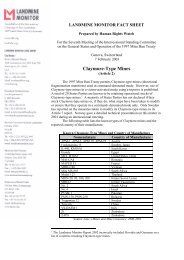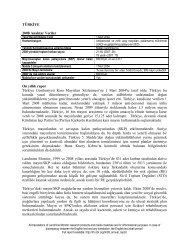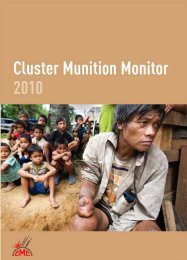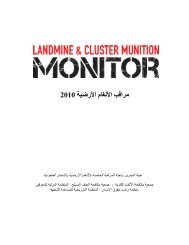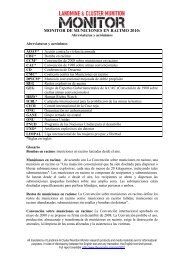Download PDF - Landmine and Cluster Munition Monitor
Download PDF - Landmine and Cluster Munition Monitor
Download PDF - Landmine and Cluster Munition Monitor
You also want an ePaper? Increase the reach of your titles
YUMPU automatically turns print PDFs into web optimized ePapers that Google loves.
© Mary Wareham/HRW, September 2011<br />
Contamination <strong>and</strong> Clearance<br />
Summary<br />
A total of 24 states <strong>and</strong> three other areas were believed to be contaminated by cluster munition remnants as of 31 July<br />
2012. Ten of these states have ratified the Convention on <strong>Cluster</strong> <strong>Munition</strong>s, while another three have signed, but not yet<br />
ratified. Seven states—Bosnia <strong>and</strong> Herzegovina (BiH), Cambodia, Iraq, Lao PDR, Lebanon, Serbia, <strong>and</strong> Vietnam—as<br />
well as Nagorno-Karabakh have estimated contamination that covers more than ten square kilometers of l<strong>and</strong>.<br />
The <strong>Monitor</strong> has calculated that in 2011, at least 52,845 unexploded submunitions were destroyed during clearance<br />
operations of some 55km 2 of l<strong>and</strong> contaminated by cluster munitions in 10 states <strong>and</strong> two other areas. This data is,<br />
however, known to be incomplete.<br />
Five contaminated States Parties <strong>and</strong> signatories conducted clearance of unexploded submunitions in 2011; Croatia,<br />
Iraq, Lao PDR, Lebanon, <strong>and</strong> Norway. Afghanistan cleared ab<strong>and</strong>oned cluster munitions at Kabul Airport. Clearance of<br />
cluster munition remnants was also conducted in non-signatories Cambodia, Libya, Serbia, South Sudan, <strong>and</strong> Vietnam,<br />
as well as Nagorno-Karabakh <strong>and</strong> Western Sahara. The Republic of the Congo (Congo), signatory to the convention,<br />
is believed to have completed clearance of unexploded submunitions in 2012, while in 2011 non-signatory Thail<strong>and</strong><br />
completed clearance of its sole area contaminated by cluster munitions.<br />
Global Contamination<br />
<strong>Cluster</strong> munition remnants are defined in the convention as covering four types of hazard; unexploded submunitions,<br />
unexploded bomblets, failed cluster munitions, <strong>and</strong> ab<strong>and</strong>oned cluster munitions. 1 Unexploded submunitions pose the<br />
greatest threat to civilians, primarily as a result of their sensitive fuzing, but also because of their shape, color, <strong>and</strong> metal<br />
content, which often attracts tampering, playful attention, or collection, especially by boys <strong>and</strong> young men.<br />
During a<br />
field visit to<br />
Nabitiye,<br />
Lebanon,<br />
clearance<br />
personnel<br />
demonstrated<br />
their work for<br />
delegates to<br />
the Second<br />
Meeting<br />
of States<br />
Parties to the<br />
Convention<br />
on <strong>Cluster</strong><br />
<strong>Munition</strong>s.<br />
States <strong>and</strong> other areas contaminated by cluster munition remnants<br />
Africa Americas Asia-Pacific<br />
Europe, Caucasus,<br />
<strong>and</strong> Central Asia<br />
Middle East <strong>and</strong><br />
North Africa<br />
Chad Chile Afghanistan BiH Iraq<br />
DRC Lao PDR Croatia Lebanon<br />
Mauritania Cambodia Germany Libya<br />
South Sudan Vietnam Montenegro Syria<br />
Sudan Norway Western Sahara<br />
Azerbaijan<br />
Georgia (South Ossetia)<br />
Russia (Chechnya)<br />
Serbia<br />
Tajikistan<br />
Kosovo<br />
Nagorno-Karabakh<br />
5 states 1 state 4 states 10 states <strong>and</strong> 2 areas 4 states <strong>and</strong> 1 area<br />
Note: Convention on <strong>Cluster</strong> <strong>Munition</strong> States Parties <strong>and</strong> signatories are indicated by bold <strong>and</strong> other areas by italics<br />
1<br />
Unexploded submunitions are submunitions that have been dispersed <strong>and</strong> have l<strong>and</strong>ed, but have failed to explode as intended. Unexploded<br />
bomblets are similar to unexploded submunitions but refer to “explosive bomblets” which have been dropped from a fixed-wing aircraft<br />
dispenser but have failed to explode as intended. Failed cluster munitions are cluster munitions that have been dropped or fired but the<br />
dispenser has failed to disperse the submunitions as intended. Ab<strong>and</strong>oned cluster munitions are unused cluster munitions that have been<br />
left behind or dumped, <strong>and</strong> are no longer under the control of the party that left them behind or dumped them. See Convention on <strong>Cluster</strong><br />
<strong>Munition</strong>s, Article 2, paragraphs 4, 5, 6, 7, <strong>and</strong> 15.<br />
41



